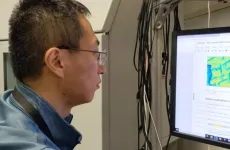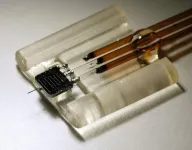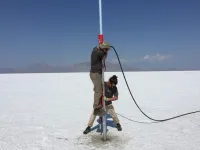(Press-News.org) Mars was once a wet world. The geological record of the Red Planet shows evidence for water flowing on the surface – from river deltas to valleys carved by massive flash floods.
But a new study shows that no matter how much rainfall fell on the surface of ancient Mars, very little of it seeped into an aquifer in the planet’s southern highlands.
A graduate student at The University of Texas at Austin made the discovery by modeling groundwater recharge dynamics for the aquifer using a range of methods – from computer models to simple back-of-the-envelope calculations.
No matter the degree of complexity, the results converged on the same answer – a miniscule .03 millimeters of groundwater recharge per year on average. That means that wherever rain fell in the model, only an average of .03 millimeters per year could have entered the aquifer and still produced the landforms remaining on the planet today.
For comparison, the annual rate of groundwater recharge for the Trinity and Edwards-Trinity Plateau aquifers that provide water to San Antonio generally ranges from 2.5 to 50 millimeters per year, or about 80 to 1,600 times the Martian aquifer recharge rate calculated by the researchers.
There are a variety of potential reasons for such low groundwater flow rates, said lead author Eric Hiatt, a doctoral student at the Jackson School of Geosciences. When it rained, the water may have mostly washed across the Martian landscape as runoff. Or it may have just not rained very much at all.
These findings can help scientists constrain the climatic conditions capable of producing rainfall on early Mars. They also suggest a very different water regime on the Red Planet than what exists on Earth today.
“The fact that the groundwater isn’t as big of a process could mean that other things are,” Hiatt said. “It might magnify the importance of runoff, or it could mean that it just didn’t rain as much on Mars. But it’s just fundamentally different from how we think about [water] on Earth.”
The results were published in the journal Icarus. The paper’s co-authors are Mohammad Afzal Shadab, a doctoral student at the Jackson School and faculty members Sean Gulick, Timothy Goudge and Marc Hesse.
The models used in the study work by simulating groundwater flow in a “steady state” environment where inflow and outflow of water into the aquifer is balanced. Scientists then changed the parameters affecting the flow – for example, where rain falls or the average porosity of the rock – and observed what other variables would have to change to maintain the steady state and how plausible those charges are.
While other researchers have simulated groundwater flow on Mars using similar techniques, this model is the first to incorporate the influence of the oceans that existed on the surface of Mars more than three billion years ago in the Hellas, Argyre, and Borealis basins.
The study also incorporates modern topographical data collected by satellites. The modern landscape, Hiatt said, still preserves one of the planet’s oldest and most influential topographical features – an extreme difference in elevation between the northern hemisphere – the lowlands – and the southern hemisphere – the highlands – known as the “great dichotomy.” The dichotomy preserves signs of past groundwater upwelling in which groundwater rose up from the aquifer to the surface. The researchers used geological markers of these past upwelling events to evaluate different model outputs.
Across different models, the researchers found the mean groundwater recharge rate of .03 millimeters per year to match most closely with what’s known about the geologic record.
The research isn’t just about understanding the Red Planet’s past. It has implications for future Mars exploration too. Understanding groundwater flow can help inform where to find water today, Hiatt said. Whether you’re looking for signs of ancient life, trying to sustain human explorers, or making rocket fuel to get back home to Earth, it’s essential to know where the water would most likely be.
The research was funded by NASA, the University of Texas Institute for Geophysics, and the UT Center for Planetary Habitability.
END
Little groundwater recharge in ancient Mars aquifer, according to new models
2024-02-22
ELSE PRESS RELEASES FROM THIS DATE:
Human-AI coworking
2024-02-21
Though artificial intelligence decreases human error in experimentation, human experts outperform AI when identifying causation or working with small data sets.
To capitalize on AI and researcher strengths, ORNL scientists, in collaboration with colleagues at National Cheng Kung University, Taiwan, and the University of Tennessee, Knoxville, developed a human-AI collaboration recommender system for improved experimentation performance.
During experiments, the system’s machine learning algorithms, described in npj Computational Materials, display preliminary ...
Vlasov and Bashir groups develop nanoscale device for brain chemistry analysis
2024-02-21
Longstanding challenges in biomedical research such as monitoring brain chemistry and tracking the spread of drugs through the body require much smaller and more precise sensors. A new nanoscale sensor that can monitor areas 1,000 times smaller than current technology and can track subtle changes in the chemical content of biological tissue with sub-second resolution, greatly outperforming standard technologies.
The device, developed by researchers at the University of Illinois Urbana-Champaign, is silicon-based and takes advantage of techniques developed for microelectronics manufacturing. ...
MD Anderson researchers receive over $25.5 million in CPRIT funding
2024-02-21
HOUSTON ― The University of Texas MD Anderson Cancer Center today was awarded 16 grants totaling over $25.5 million from the Cancer Prevention and Research Institute of Texas (CPRIT) in support of cancer screening, early detection and prevention programs, faculty recruitment, and groundbreaking cancer research across all areas of the institution.
“We are grateful for CPRIT’s continued funding of impactful cancer research and prevention programs at MD Anderson, which propels our efforts to deliver new breakthroughs and to advance our mission to end cancer,” said Peter WT Pisters, M.D., president of MD Anderson. “These efforts are pivotal to our institutional strategy ...
Hippo signaling pathway gives new insight into systemic sclerosis
2024-02-21
Systemic sclerosis causes the skin to tighten and harden resulting in a potentially fatal autoimmune condition that is associated with lung fibrosis and kidney disease.
University of Michigan Health researchers have studied the pathology of systemic sclerosis to understand better the disease and identify key pathways in the disease process that can be targeted therapeutically.
A research team led by University of Michigan Health’s Dinesh Khanna, M.B.B.S., M.Sc., professor of rheumatology and Johann Gudjonsson, M.D., Ph.D., professor of dermatology, ...
Utah’s Bonneville Salt Flats has long been in flux
2024-02-21
It has been long assumed that Utah’s Bonneville Salt Flats was formed as its ancient namesake lake dried up 13,000 years ago. But new research from the University of Utah has gutted that narrative, determining these crusts did not form until several thousand years after Lake Bonneville disappeared, which could have important implications for managing this feature that has been shrinking for decades to the dismay of the racing community and others who revere the saline pan 100 miles west of Salt ...
UM School of Medicine receives $10.6 million in state funding for Abortion Clinical Care Training Program
2024-02-21
A $10.6 million training grant has been awarded to the University of Maryland School of Medicine (UMSOM) and University of Maryland, Baltimore (UMB) to administer Maryland’s Abortion Clinical Care Training Program. The grant will be used to expand the number of healthcare professionals with abortion care training, increase the racial and ethnic diversity among health care professionals with abortion care education, and support the identification of clinical sites needing training.
“Our training will target a major ...
Outsmarting chemo-resistant ovarian cancer
2024-02-21
· Most women with ovarian cancer develop resistance to chemotherapy
· Nanoparticle fools cancer cells and prevents cholesterol from entering
· More than 18,000 women a year die from ovarian cancer
CHICAGO --- Women diagnosed with ovarian cancer may initially respond well to chemotherapy, but the majority of them will develop resistance to treatment and die from the disease.
Now Northwestern Medicine scientists have discovered the Achilles heel of chemotherapy-resistant ovarian cancer — its hunger for cholesterol — and how to sneakily use that to destroy it.
In a new study, scientists first showed that chemotherapy-resistant ...
Does Russia stand to benefit from climate change?
2024-02-21
“There’s a narrative out there about climate change that says there are winners and losers. Even if most of the planet might lose from the changing climate, certain industries and countries stand to benefit. And Russia is usually at the tip of people’s tongues, with Russian officials even making the claim that Russia is a potential winner.”
This portrayal, described by Debra Javeline, associate professor of political science at the University of Notre Dame and lead author on the recently published study “Russia in a changing climate,” was debated ...
Researchers find possible solutions to reverse Alzheimer’s Disease impact
2024-02-21
University of North Carolina at Chapel Hill researchers have developed a new drug delivery platform that harnesses helical amyloid fibers designed to untwist and release drugs in response to body temperatures.
A new research paper published on Jan. 26 in Nature Communications reveals groundbreaking structural details into how diseases form much like Alzheimer’s disease. With this knowledge, the group may have uncovered a unique mechanism to reverse both the deposits and their impact on those suffering from these conditions.
UNC-Chapel Hill researcher Ronit Freeman ...
A Mount Sinai-led study shows early success of a novel drug in treating a rare and chronic blood cancer
2024-02-21
New York, NY (February 21, 2024) – A novel treatment for polycythemia vera, a potentially fatal blood cancer, demonstrated the ability to control overproduction of red blood cells, the hallmark of this malignancy and many of its debilitating symptoms in a multi-center clinical trial led by the Icahn School of Medicine at Mount Sinai.
In the phase 2 study, the drug rusfertide limited excess production of red blood cells, the main manifestation of polycythemia vera, over the 28-week course of ...





